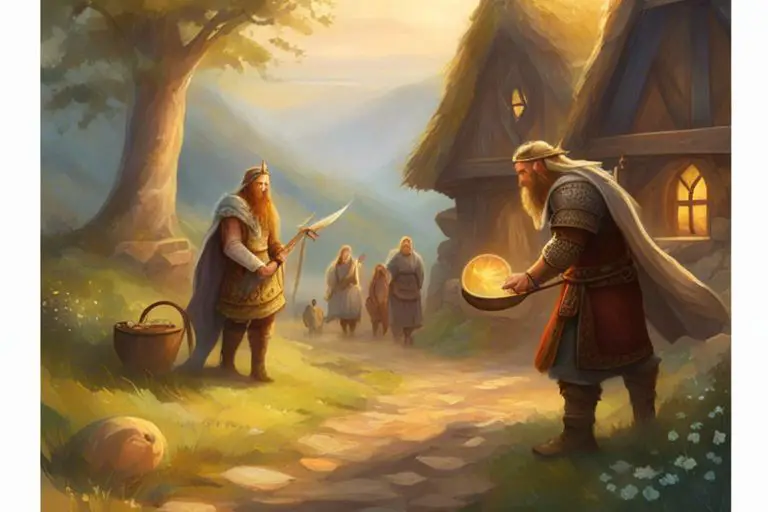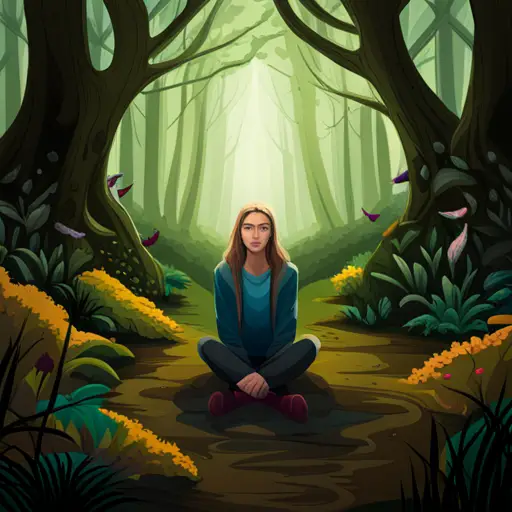As a lover of mythology, I find myself drawn to the lesser-known goddesses of ancient cultures. One such goddess is Lofn from Norse mythology, also known as the goddess of forbidden love. Her role in Norse mythology is often overlooked, but her significance is undeniable.
Through her myths and legends, Lofn represents the power of love and the lengths that people will go to be with the ones they love. Lofn’s story is one of mystery and intrigue, as she was a goddess who facilitated the love between two individuals who were otherwise unable to be together. Her role as a mediator of forbidden love is fascinating, and her myths have captured the hearts of many.
In this article, we will explore the origin and significance of Lofn in Norse mythology, her role as a facilitator of forbidden love, her myths and legends, and her comparisons to other Norse goddesses. Join me as we delve into the world of Lofn and uncover the legacy she has left on modern culture.
The Origin and Significance of Lofn in Norse Mythology
You’re about to learn where Lofn came from and why she’s an important figure in the myths of ancient Scandinavia.
Lofn is a goddess of love and marriage, and her name means ‘praise’ or ‘permission.’ She is said to be the daughter of the god of mischief, Loki, and the goddess of the underworld, Angrboda.
Lofn played an important role in Norse mythology as a mediator between lovers who were prohibited from being together. She had the power to soften the hearts of those who opposed such love and to grant permission for the union to take place.
This made her an ally to many couples who were struggling to overcome obstacles in their relationships, and her presence brought them hope and reassurance.
In the next section, we’ll explore more about Lofn’s role as a facilitator of forbidden love.
Lofn’s Role as a Facilitator of Forbidden Love
As a facilitator of love that was deemed taboo, Lofn played a crucial role in bringing together couples who were not allowed to be together. Her power to soften the hearts of those who opposed such relationships was unmatched.
Lofn’s gentle and persuasive nature made her a goddess of great importance to those who were bound by societal norms and customs that prevented them from expressing their love in the way they desired. Lofn’s role in facilitating forbidden love is a testament to the power of love itself.
Her presence in Norse mythology serves as a reminder that love knows no boundaries, and that it can conquer even the most rigid and inflexible of societal constructs. Lofn’s influence on the lives of those she touched is a testament to the enduring power of love, and her stories continue to inspire and captivate audiences to this day.
Lofn’s Myths and Legends
The myths and legends surrounding Lofn showcase the timeless power of love to overcome societal barriers.
One of her most famous stories tells of a young couple who couldn’t marry due to their different social status. In desperation, they sought the help of Lofn, who used her magic to persuade their families to allow them to be together. Through her intervention, Lofn enabled their love to triumph over the constraints of society.
Another story tells of a woman who fell in love with a man who was already betrothed to another woman. Despite the odds being against her, the woman turned to Lofn for help. Once again, Lofn used her powers to bring the couple together, and their union was blessed with happiness and prosperity.
These stories not only reflect the power of love but also demonstrate Lofn’s ability to help those who are willing to fight for their love. As we explore more of Lofn’s story, we can compare her to other Norse goddesses who share similar traits and powers.
Lofn’s Comparisons to Other Norse Goddesses
Comparing her to other powerful goddesses, it’s fascinating to note that Freyja, the goddess of love and fertility, was also known for her ability to use magic to help lovers overcome obstacles in their path. However, unlike Lofn, Freyja was also associated with war, battle, and death.
She was a fierce warrior who led the Valkyries into battle and claimed half of the warriors who died in battle to come live with her in the afterlife. In contrast, Lofn was a more gentle and peaceful goddess who used her powers to help lovers who faced societal or familial opposition to their love.
Another goddess that Lofn can be compared to is Frigg, the goddess of marriage, motherhood, and fertility. Like Lofn, Frigg was also associated with love and relationships, but her focus was more on maintaining the stability and sanctity of marriage.
She was known for her wisdom and foresight, and was often consulted by the other gods for advice. However, unlike Lofn, Frigg was not associated with forbidden or taboo love. Instead, she was a symbol of the ideal wife and mother, and was often worshipped by women who sought her blessings for their marriages and children.
Transitioning into the next section, it’s fascinating to see how Lofn’s legacy has been interpreted and reimagined in modern culture.
The Legacy of Lofn in Modern Culture
Love stories and romance novels have drawn inspiration from the gentle and magical nature of Lofn, creating new tales of love overcoming societal obstacles. Lofn’s story is one that resonates with many people, as forbidden love is a timeless theme that captures our hearts and imaginations.
In modern culture, Lofn has become a symbol of hope and perseverance in the face of adversity, reminding us that love can conquer all. Lofn’s legacy can be seen in various forms of media, from movies to TV shows to music. Her influence can be felt in stories like Romeo and Juliet, where two lovers from rival families are willing to risk it all for their love.
In the world of music, artists like Taylor Swift have incorporated the theme of forbidden love into their lyrics, drawing inspiration from Lofn’s story. Overall, Lofn’s legacy serves as a reminder that love is a powerful force that can transform lives and inspire us to be our best selves.
Frequently Asked Questions
What are the other lesser-known gods and goddesses in Norse mythology?
To be honest, I’ve always been fascinated by Norse mythology. It’s not just about Thor and Odin; there are so many other lesser-known gods and goddesses that are just as interesting.
For example, there’s Njord, the god of the sea and winds, who’s said to have the power to calm the roughest of waters.
And then there’s Eir, the goddess of healing, who provides comfort and relief to those who are sick or injured.
These gods and goddesses may not be as famous as the others, but they still play an important role in the mythology.
How did people worship Lofn in ancient times?
When it comes to worshiping lesser-known gods and goddesses in Norse mythology, it’s important to consider the time period and culture in which they were revered. Some may have been worshiped through offerings or sacrifices, while others may have had specific rituals or festivals dedicated to them.
As for Lofn, the goddess of forbidden love, it’s unclear how she was worshiped in ancient times due to limited historical records. However, it’s possible that she was venerated by those seeking her aid in matters of love and desire, or perhaps she was honored as a protector of those in forbidden or illicit relationships.
Ultimately, the specifics of Lofn’s worship remain a mystery, but her enduring presence in Norse mythology speaks to the enduring human fascination with the power and complexity of love.
What was the response of other gods and goddesses to Lofn’s role as a facilitator of forbidden love?
As I delved into the role of Lofn in Norse mythology, I couldn’t help but wonder how other gods and goddesses reacted to her being the facilitator of forbidden love.
It was clear that Lofn’s role was not widely accepted, and other deities viewed her with suspicion. However, as I dug deeper, I discovered that some gods secretly admired Lofn’s bravery and romantic spirit.
They saw her as a symbol of passion and love, and although they couldn’t publicly support her, they appreciated her role in the Norse pantheon. It was fascinating to see how even the gods had conflicting views on love and its forbidden nature.
Are there any known symbols or artifacts associated with Lofn?
When it comes to symbols or artifacts associated with Lofn, there isn’t much information available.
As a goddess of love, it makes sense that she may have been depicted with flowers or hearts, but there’s no concrete evidence to support this.
However, it’s important to remember that Norse mythology was an oral tradition, and many symbols and artifacts may have been lost over time.
As someone who’s fascinated by mythology, I appreciate the mystery surrounding Lofn and the many other gods and goddesses of Norse mythology.
It makes me feel connected to something bigger than myself, and I find comfort in knowing that these stories and traditions have been passed down for generations.
How has Lofn’s character evolved over time in various retellings of Norse mythology?
As I delved into the various retellings of Norse mythology, I couldn’t help but notice the evolution of Lofn’s character over time.
While she was initially known as the goddess of forbidden love, her portrayal became more complex as time passed. In some versions, she was seen as a mediator between lovers, while in others, she was depicted as a protector of marriage.
Despite the changes, her underlying theme of love remained constant and her presence was felt in the hearts of those seeking acceptance in a world that often frowned upon their desires.
It’s fascinating to see how a character can evolve and adapt to the changing times while still retaining their core essence.
Conclusion
Wow, who knew that Norse mythology had a goddess specifically dedicated to forbidden love?
Lofn’s role as a facilitator of taboo relationships is certainly intriguing, and her myths and legends are definitely worth looking into. It’s fascinating to see how Lofn compares to other Norse goddesses, and her legacy in modern culture is definitely something to explore.
But let’s be real here, who needs a goddess to facilitate forbidden love? As if we needed any more encouragement to pursue the things we know we shouldn’t!
Maybe we should all take a page out of Lofn’s book and embrace our rebellious sides a little more. After all, who wants to live a life without a little bit of excitement and risk?
Just don’t blame it on the goddess if things don’t go quite as planned.





